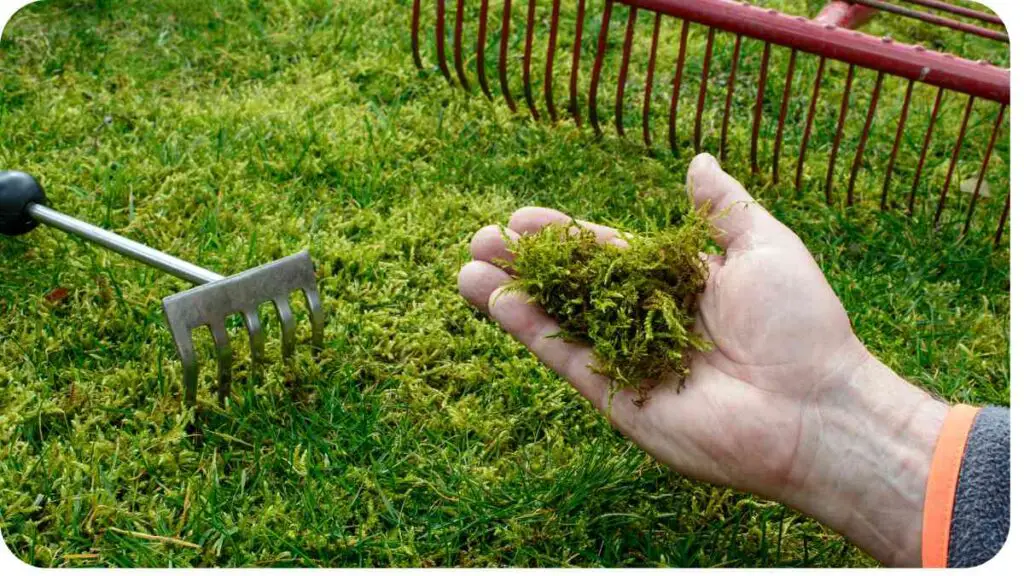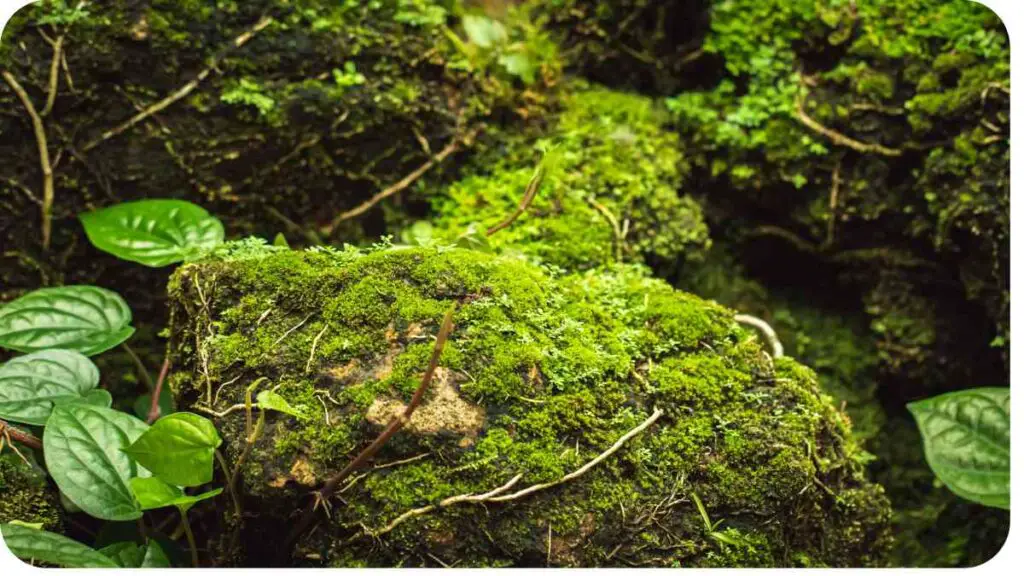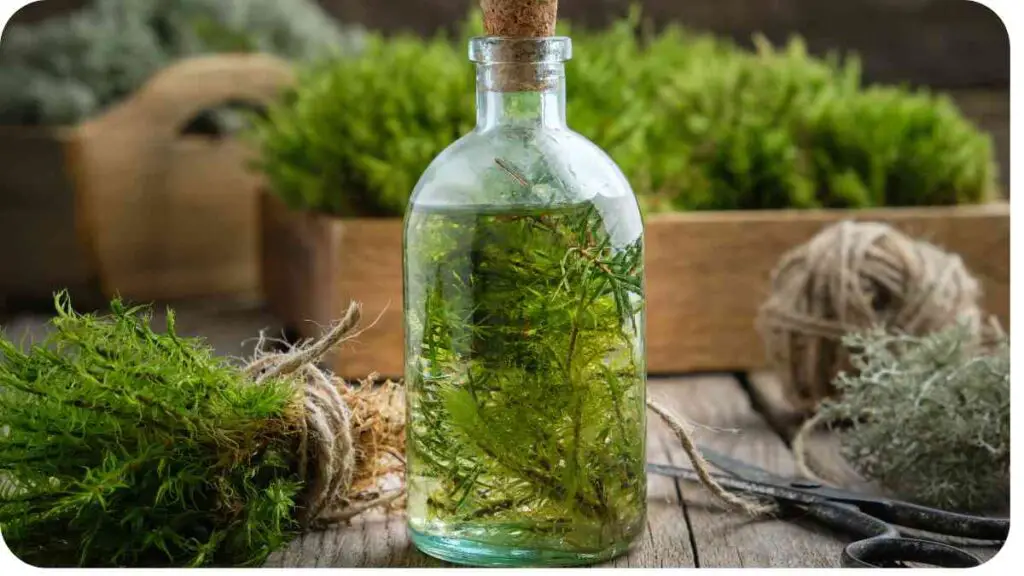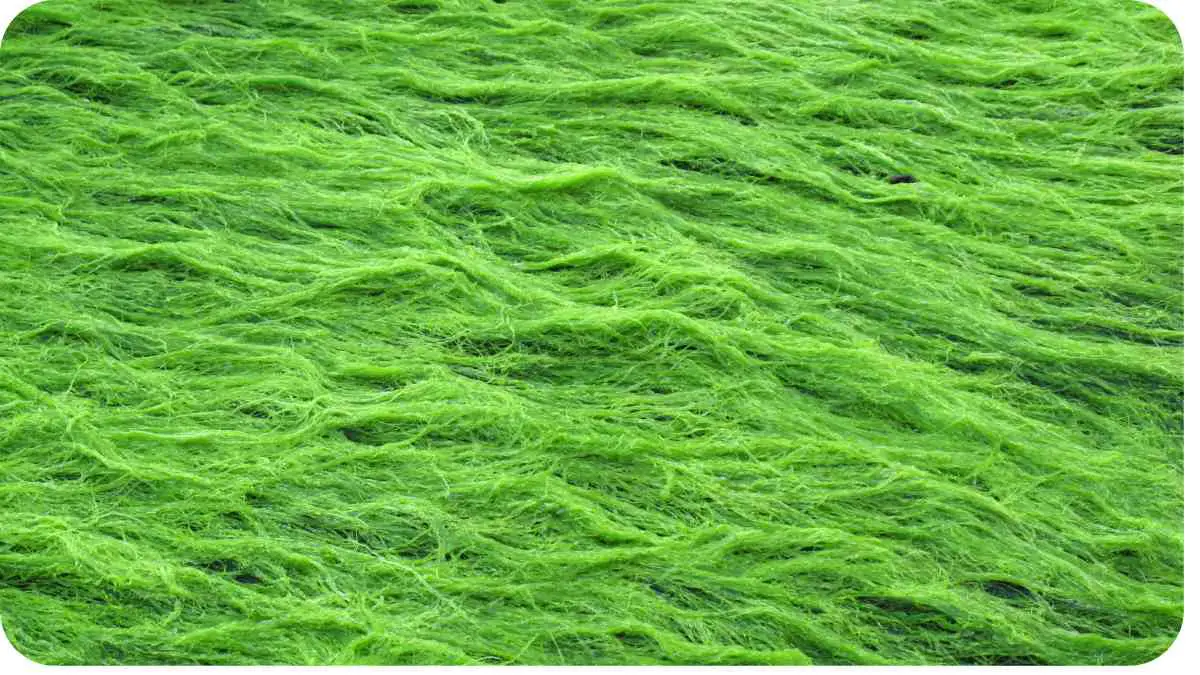Dealing with moss and algae growth in your yard can be a challenging task, but with the right knowledge and strategies, you can effectively manage and prevent their proliferation. In this comprehensive guide, we’ll delve into the causes of moss and algae growth, the risks they pose to your yard, and most importantly, how to deal with them effectively.
| Takeaways |
|---|
| Understanding the characteristics of moss and algae is essential for effective management. |
| Identifying causes such as shade, moisture, poor drainage, soil compaction, and pH imbalance can help prevent moss and algae growth. |
| Assessing risks, including damage to plants, safety hazards from slippery surfaces, and aesthetic concerns, can guide your management strategies. |
| Implementing prevention methods such as improving sunlight exposure, enhancing drainage, relieving soil compaction, and balancing soil pH are crucial for preventing moss and algae growth. |
| Exploring treatment options, including natural remedies, chemical treatments, and mechanical removal methods, offers various approaches for controlling existing moss and algae infestations. |
| Maintaining a healthy yard through regular inspections, proper lawn care practices, and post-treatment care is essential for preventing future outbreaks of moss and algae. |
| Persistence and consistency are key when it comes to managing moss and algae. Regular maintenance and proactive prevention measures will help keep your yard healthy and beautiful. |
Understanding Moss and Algae

What is Moss?
Mosses are small, non-vascular plants that thrive in moist and shady environments. They reproduce via spores and often form dense mats or clumps on surfaces such as soil, rocks, and even trees.
Addressing lawn thatch buildup is crucial to maintaining a healthy yard. By understanding the causes and solutions of thatch buildup, homeowners can take proactive steps to prevent moss and algae growth, ensuring a lush, green lawn year-round.
| Characteristics of Moss | Description |
|---|---|
| Habitat | Moist and shaded areas |
| Reproduction | Spores |
| Appearance | Dense mats or clumps |
| Common Species | Bryum, Hypnum, Sphagnum, etc. |
What is Algae?
Algae, on the other hand, are simple, plant-like organisms that can range from microscopic single-celled forms to large, multicellular seaweeds. They thrive in aquatic environments but can also colonize damp surfaces in terrestrial habitats.
| Characteristics of Algae | Description |
|---|---|
| Habitat | Aquatic environments, damp surfaces |
| Reproduction | Spores, fragmentation, or cell division |
| Appearance | Green, brown, or red coloration |
| Common Types | Green algae, red algae, brown algae |
Understanding the characteristics of moss and algae is crucial for effective management and prevention strategies.
Causes of Moss and Algae Growth
Moss and algae thrive under specific conditions. Understanding these causes can help you address the underlying issues and prevent their proliferation.
Shade and Moisture
Moss and algae prefer damp, shady environments. Areas with limited sunlight and poor air circulation create the perfect conditions for their growth. Overhanging trees, tall structures, or dense foliage can contribute to excess shade and moisture retention.
Diagnosing and rectifying yellow grass patches is essential for preventing moss and algae infestations. Proper lawn care practices can mitigate these issues, promoting a healthier, more resilient yard that resists unwanted moss and algae.
Poor Drainage
Inadequate drainage can lead to waterlogged soil, creating a conducive environment for moss and algae. Compacted soil, improper grading, or clogged gutters can hinder proper water runoff, allowing moisture to accumulate and promote growth.
Compacted Soil
Compacted soil restricts root growth and reduces air circulation, creating favorable conditions for moss and algae. High foot traffic, heavy equipment, or poor soil composition can contribute to soil compaction, exacerbating the problem.
Imbalanced pH Levels
Mosses thrive in acidic environments, while algae prefer neutral to alkaline conditions. Imbalanced pH levels in the soil can favor the growth of moss and algae. Acidic soils are common in areas with high rainfall and organic debris accumulation.
Understanding these underlying causes is essential for implementing effective prevention strategies and maintaining a healthy yard.
Soil compaction can significantly impact lawn health, creating conditions that favor moss and algae. Learning tips for better plant growth by addressing soil compaction can enhance overall yard vitality and reduce the likelihood of these unwanted growths.
The Risks of Moss and Algae in Your Yard

While moss and algae may seem harmless, they can pose several risks to your yard’s health and safety.
Damage to Plants
Excessive moss growth can smother and suffocate grass and other plants, depriving them of sunlight and nutrients. Algae can compete with plants for resources and hinder their growth. Over time, moss and algae infestations can weaken and kill off vegetation, leading to bare patches and erosion.
Slippery Surfaces
Moss and algae-covered surfaces can be extremely slippery, posing a safety hazard. Wet moss and algae create slick conditions on walkways, driveways, and patios, increasing the risk of slips, trips, and falls. This is especially dangerous in shaded areas or after rainfall when surfaces remain moist.
Aesthetic Concerns
Moss and algae growth can detract from the aesthetic appeal of your yard. Unsightly green patches or slimy coatings can diminish the beauty of your landscaping efforts. Additionally, moss and algae can cling to hardscapes, roofs, and outdoor furniture, detracting from their appearance and requiring frequent cleaning and maintenance.
By understanding these risks, you can take proactive measures to address moss and algae growth and maintain a healthy, safe, and visually appealing yard.
How to Prevent Moss and Algae Growth
Preventing moss and algae growth requires addressing the underlying causes and implementing proactive measures to create unfavorable conditions for their proliferation.
Improving garden drainage is vital to maintaining a healthy yard. Understanding common issues and fixes for poor drainage can help prevent the damp conditions that moss and algae thrive in, promoting a drier, healthier lawn environment.
Improving Sunlight Exposure
Increasing sunlight exposure in shaded areas can inhibit moss and algae growth. Trim back overhanging branches, thin out dense foliage, or strategically prune trees to allow more sunlight to reach the ground. Consider planting shade-tolerant grass or ground cover alternatives in areas with persistent shade.
| Shade Reduction Techniques | Description |
|---|---|
| Tree Pruning | Trimming back branches to allow more sunlight |
| Thinning Foliage | Removing excess vegetation for better light penetration |
| Plant Selection | Choosing shade-tolerant species for landscaping |
Enhancing sunlight exposure can help create less hospitable conditions for moss and algae to thrive.
Enhancing Drainage
Improving drainage is crucial for preventing water accumulation and reducing moisture levels in the soil. Ensure that gutters and downspouts are clear of debris and direct water away from the foundation of your home. Consider installing French drains, adding gravel or mulch to low-lying areas, or incorporating rain gardens to absorb excess water.
| Drainage Improvement Methods | Description |
|---|---|
| Gutter Maintenance | Regular cleaning and inspection of gutters and downspouts |
| French Drain Installation | Redirecting water away from problem areas |
| Rain Garden Creation | Planting water-absorbing vegetation to manage runoff |
By enhancing drainage, you can minimize moisture retention and create a less favorable environment for moss and algae.
Aeration and Compaction Relief
Aerating the soil and relieving compaction can improve soil structure and promote better drainage. Use a core aerator to perforate compacted soil and allow air, water, and nutrients to penetrate the root zone. Incorporate organic matter, such as compost or peat moss, into the soil to improve its texture and fertility.
| Soil Aeration and Compaction Relief Techniques | Description |
|---|---|
| Core Aeration | Breaking up compacted soil to improve aeration |
| Organic Matter Incorporation | Adding compost or peat moss to enhance soil structure |
Aerating the soil can help alleviate compaction and create optimal growing conditions for grass and plants while discouraging moss and algae growth.
Soil Testing and pH Balancing
Conducting soil tests and balancing pH levels can help create conditions less favorable for moss and algae. Test your soil’s pH levels using a home testing kit or by sending samples to a local extension service. If the soil is too acidic, consider applying lime to raise the pH and create a less hospitable environment for moss. Conversely, if the soil is too alkaline, amend it with sulfur or acidic fertilizers to lower the pH.
Fixing uneven grass steps is an important part of lawn maintenance. Uneven areas can harbor moisture, leading to moss and algae growth. By addressing these issues, homeowners can ensure a smooth, healthy lawn free from unwanted vegetation.
| Soil Testing and pH Balancing Techniques | Description |
|---|---|
| Soil pH Testing | Determining the acidity or alkalinity of the soil |
| pH Adjustment | Adding lime or sulfur to balance soil pH levels |
Maintaining balanced pH levels in the soil can help discourage moss and algae growth and promote the health of your lawn and plants.
By implementing these prevention methods, you can effectively manage moss and algae growth in your yard and maintain a lush, vibrant landscape. In the next sections, we’ll explore natural and chemical remedies for dealing with existing moss and algae infestations.
Natural Remedies for Moss and Algae

Natural remedies offer environmentally friendly alternatives for controlling moss and algae without resorting to harsh chemicals.
Vinegar Solution
Vinegar is a natural acidic solution that can effectively kill moss and algae on surfaces. Mix equal parts white vinegar and water in a spray bottle and apply it directly to moss and algae-infested areas. Allow the solution to sit for a few hours or overnight, then scrub the affected surfaces with a stiff brush or broom. Rinse thoroughly with water to remove any residue.
Baking Soda
Baking soda, or sodium bicarbonate, can also help control moss and algae growth. Sprinkle baking soda directly onto affected surfaces and allow it to sit for several hours. The alkaline nature of baking soda disrupts the pH balance of moss and algae, inhibiting their growth. Afterward, scrub the treated areas with a brush or rinse them with water to remove debris.
Sunlight Exposure
Increasing sunlight exposure to moss and algae-infested areas can naturally inhibit their growth. Trim back overhanging branches or prune nearby vegetation to allow more sunlight to reach the affected surfaces. Regularly rake or remove organic debris, such as leaves or mulch, to prevent moisture accumulation and create less hospitable conditions for moss and algae.
| Natural Remedies for Moss and Algae | Description |
|---|---|
| Vinegar Solution | Acidic solution that kills moss and algae on surfaces |
| Baking Soda | Alkaline substance that disrupts the pH balance of moss and algae |
| Sunlight Exposure | Increasing sunlight to inhibit moss and algae growth |
Chemical Treatments for Moss and Algae
Chemical treatments can provide quick and efficient solutions for eliminating stubborn moss and algae infestations.
Copper-Based Solutions
Copper-based products, such as copper sulfate or copper fungicides, are commonly used to control moss and algae growth. These compounds are toxic to moss and algae and can be applied as sprays or granules to affected areas. Copper works by disrupting cellular processes in moss and algae, ultimately leading to their demise.
Algaecides
Algaecides are chemicals specifically designed to kill algae. They come in various formulations, including liquid concentrates, granules, and tablets. Algaecides contain active ingredients such as copper compounds, quaternary ammonium compounds, or sodium hypochlorite, which effectively eradicate algae on contact.
Herbicides
Selective herbicides can be used to target moss and algae growing in lawns or other turf areas. These herbicides contain active ingredients such as iron sulfate or potassium salts of fatty acids, which selectively kill moss and algae while sparing desirable grasses and plants. Follow label instructions carefully when applying herbicides to avoid damage to surrounding vegetation.
| Chemical Treatments for Moss and Algae | Description |
|---|---|
| Copper-Based Solutions | Toxic to moss and algae, disrupts cellular processes |
| Algaecides | Designed to kill algae on contact, available in various formulations |
| Herbicides | Selectively target moss and algae in lawns and turf areas |
When using chemical treatments, always follow label instructions, wear appropriate protective gear, and take precautions to minimize environmental impact.
In the next sections, we’ll explore mechanical removal methods for tackling moss and algae infestations in your yard.
Mechanical Removal Methods
Mechanical removal methods involve physically removing moss and algae from surfaces using manual or powered tools.
Scraping and Brushing
Scraping and brushing are effective methods for removing moss and algae from hard surfaces such as driveways, walkways, and patios. Use a stiff-bristled brush or scraper to dislodge moss and algae growth, then sweep or rinse away the debris. For stubborn growth, apply gentle pressure and use back-and-forth motions to loosen the moss and algae from the surface.
Pressure Washing
Pressure washing is a powerful method for removing moss and algae from various surfaces, including concrete, wood, and brick. Use a pressure washer with an appropriate nozzle and setting to apply a concentrated stream of water to the affected areas. Start with low pressure to avoid damaging delicate surfaces, then gradually increase the pressure as needed to remove stubborn moss and algae growth.
Hand-Pulling
Hand-pulling is a labor-intensive but effective method for removing moss and algae from small areas or between cracks and crevices. Wear gloves to protect your hands and manually pull the moss and algae away from the surface. Be thorough in your efforts to remove as much of the growth as possible, taking care to extract the roots or attachment points to prevent regrowth.
| Mechanical Removal Methods for Moss and Algae | Description |
|---|---|
| Scraping and Brushing | Dislodging moss and algae from hard surfaces using manual tools |
| Pressure Washing | Applying a concentrated stream of water to remove growth from surfaces |
| Hand-Pulling | Manually removing moss and algae from small areas or tight spaces |
Maintaining a Moss and Algae-Free Yard
After treating moss and algae infestations, it’s essential to implement ongoing maintenance practices to prevent their return.
Regular Inspections
Schedule regular inspections of your yard to monitor for signs of moss and algae growth. Pay attention to shaded areas, low-lying spots, and areas with poor drainage, as these are prime locations for infestations to occur. Promptly address any new growth to prevent it from spreading and becoming more challenging to control.
Proper Lawn Care Practices
Maintaining a healthy lawn can help prevent moss and algae from taking hold. Practice good lawn care habits, such as mowing at the appropriate height, watering deeply but infrequently, and fertilizing as needed. Overseed thin or bare patches to promote dense grass growth and reduce opportunities for moss and algae to establish themselves.
Post-Treatment Care
After treating moss and algae infestations, follow up with post-treatment care to ensure long-term success. Monitor treated areas for regrowth and reapply treatments as needed. Implement preventive measures, such as improving sunlight exposure, enhancing drainage, and balancing soil pH, to create less favorable conditions for moss and algae.
By incorporating these maintenance practices into your routine, you can keep your yard healthy, vibrant, and free from moss and algae.
Conclusion
Dealing with moss and algae growth in your yard requires a multifaceted approach that addresses the underlying causes and implements effective treatment and prevention methods. By understanding the characteristics of moss and algae, recognizing the risks they pose, and utilizing a combination of natural, chemical, and mechanical removal methods, you can effectively control their proliferation and maintain a healthy, vibrant landscape.
Key takeaways include:
- Understanding Moss and Algae: Knowing the characteristics and habits of moss and algae is essential for effective management.
- Identifying Causes: Addressing factors such as shade, moisture, poor drainage, soil compaction, and pH imbalance can help prevent moss and algae growth.
- Assessing Risks: Recognizing the potential damage to plants, safety hazards from slippery surfaces, and aesthetic concerns can guide your management strategies.
- Implementing Prevention Methods: Improving sunlight exposure, enhancing drainage, relieving soil compaction, and balancing soil pH are crucial preventive measures.
- Exploring Treatment Options: Natural remedies, chemical treatments, and mechanical removal methods offer various approaches for controlling existing moss and algae infestations.
- Maintaining a Healthy Yard: Regular inspections, proper lawn care practices, and post-treatment care are essential for preventing future outbreaks.
By incorporating these strategies into your yard maintenance routine, you can effectively manage moss and algae growth and enjoy a lush, green landscape year-round.
Remember, persistence and consistency are key when it comes to managing moss and algae. Regular maintenance, prompt treatment of infestations, and proactive prevention measures will help keep your yard healthy and beautiful.
If you encounter challenges or have specific questions about managing moss and algae in your yard, don’t hesitate to seek advice from local gardening experts or extension services. They can provide personalized recommendations based on your unique circumstances and help you achieve long-term success.
With the right knowledge, tools, and dedication, you can maintain a moss and algae-free yard that enhances the beauty and enjoyment of your outdoor space for years to come.
Thank you for reading our comprehensive guide on dealing with moss and algae growth in your yard. We hope you found it informative and valuable in your quest for a healthier, greener landscape.
Further Reading
Here are some additional resources for further information on dealing with moss and algae growth in your yard:
- Rolawn: Algae and Moss in Lawns: Explore tips and strategies for managing algae and moss in your lawn.
- Paul Munns Instant Lawn: Moss and Algae: Learn about the causes of moss and algae and how to effectively treat them in your lawn.
- Royal Horticultural Society (RHS): Moss on Lawns: Discover guidance from the RHS on identifying and controlling moss on lawns.
FAQs
How does moss and algae affect my lawn?
Moss and algae can compete with grass for nutrients and moisture, leading to thinning turf and bare patches.
What are the common causes of moss and algae growth?
Shade, poor drainage, compacted soil, and imbalanced pH levels are common factors contributing to moss and algae growth.
Are there natural remedies for controlling moss and algae?
Yes, natural remedies such as vinegar solutions and increased sunlight exposure can help inhibit moss and algae growth.
Can I use chemical treatments to eliminate moss and algae?
Chemical treatments, such as copper-based solutions and algaecides, can effectively eradicate moss and algae infestations.
What maintenance practices can help prevent moss and algae?
Regular inspections, proper lawn care practices, and post-treatment care are essential for preventing moss and algae growth in your yard.

Hi! My name is Hellen James, and I’m here to help you with your home-maintenance needs. Whether it’s building a better yard or just trying to fix a garden—I can show you how.


